| |
"What does it mean to be a patriot? Is it to blindly support American warmongering? To turn your back on friendly neighbouring countries? Or is it to fight for the Norwegian way of life and encourage friendship across borders? Many labels were put on Arne Treholt after he met Russian diplomats in Vienna to chat about illegal US activity. But none of these labels describe Commander Treholt, as the word 'patriot' isn't here. Nor the word that no-one dared speak: Ninja." |
|
The film's introduction to Arne Treholt |
What was your first reaction on hearing the title Norwegian Ninja? A smile, perhaps? An audible snigger? One thing's for sure, we're not meant to take such a film seriously. I mean, come on, Norwegian Ninja? But why? Do we scoff as readily at the term American Ninja? (You might if you'd seen the film bearing this title, but that's beside the point.) Are we so culturally programmed that the very idea of a Scandinavian stealth warrior seems automatically absurd? It just so happens that on this occasion you're allowed and even expected to smirk, as Norwegian writer-director Thomas Cappelen Malling clearly finds the concept amusing as well. Or does he? In interviews, Malling always talks about the authenticity of his story, and there are some intriguing and socially specific aspects to Norwegian Ninja that separate it from the run-of-the-mill action parody, which I'll get to after the requisite plot outline.
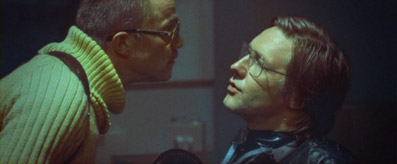
It's early 1980s Norway, and two secretive military units operate in what appears to be complete opposition to each other. On one hand we have a group known as Stay Behind led by Hans Otto Meyer, which can operate invisibly and commit terrorist attacks that it blames on Russian agents and communist groups, whom it bitterly opposes. On the other are the Ninjas led by Commander Arne Threholt, who are loyal to King Olav V and live and train on the idyllic, sepia-tinted Grassy Island (yes, that's its name) and have dedicated themselves to foiling and exposing the activities of Stay Behind.
All of which sounds rather like the outline for a straight-up martial arts actioner, but it becomes quickly evident that it's nothing of the sort. As a comedic piss-take, however, it's a distinctly odd fish. Really daft things unfold, but Malling's deadpan approach makes it difficult at times to pinpoint where the line between comedy and drama sits, or even if it exists at all, particularly as some of the ninjas' more outlandish abilities would not be out of place in the increasingly over-the-top world of the modern action movie. Intermittently, however, the silliness graduates to inspired absurdity: the painfully obvious model shots and blatantly visible strings; Treholt's ability to appear and disappear in a puff of smoke like an old school stage magician and restart a heart with the energy from his fists; the search for submarines that ends with a group of bored submariners sitting around on the bed of the fjord in their diving suits drinking beer; the camp-side claim that "If the good Lord wanted us to be vegetarians then all vegetables would be made of meat." I could go on.
But there's also a cultural element at play here, and I'm not just talking about the pitch of the humour. Far from being an invention of the filmmakers, Arne Treholt is a real person, a former politician and diplomat who in 1984 was convicted of high treason in what is generally regarded as the most serious espionage case in modern Norwegian history. He was sentenced to twenty years in prison, but the official (mis-) handling of the case and Treholt's deteriorating health led to a controversial pardon in 1992. Treholt settled in Russia, one of the countries he was accused of selling secrets to, and has twice requested that the case be reviewed by the Supreme Court of Norway and the Criminal Cases Review Commission. Both requests were denied, though the publication of a book claiming police evidence had been falsified has finally prompted the case to be re-opened.
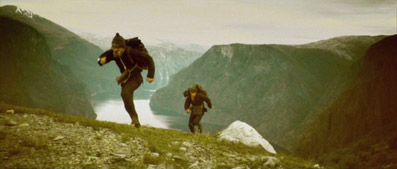
It's information anyone not too familiar with Norwegian social and political history would do well to read up on before watching the film, as without it the film's widespread use of stock footage and real world news broadcasts will likely come across as a cheapjack ploy, and add a few more stutters to the film's already staccato pacing. What you're unlikely to find, no matter how hard you search, is any evidence that Treholt was the leader of a group of mystically skilled and fiercely patriotic ninjas. Indeed, in spite of the front-of-film claim that we're watching a true story, it's safe to say Norwegian Ninja (whose original title is Kommandør Treholt: Ninjatroppen) is about as accurate a portrait of the real Arne Treholt as the Comic Strip's glorious 1990 parody GLC: The Carnage Continues was of Greater London Council leader Ken Livingston.
But as with GLC, in the process of mythologising their character to a such a degree, Melling and his team have dressed a political statement up in comedy clothing, painting Treholt as a loyal patriot who is dedicated to undermining and exposing the activities of Stay Behind, a CIA-backed organisation that commits terrorists acts for the sole purpose of incriminating its opponents. Paradoxically, its actions are also committed in the name of patriotism, its philosophy neatly captured in its recruitment video: "Would you kill one person to save a thousand?" it asks. "Then you'd kill 4,500 to save all of Norway. Then you're one of us."
Norwegian Ninja is an enjoyably oddball creation, a comical (and, given the incorporation of a number of real-life catastrophes, downright risky) re-writing of modern Norwegian history, one that openly criticises covert American operations on Norwegian turf and casts a man some still regard as the country's most notorious traitor in the role of a patriotic martial arts hero. Unevenly paced and structured, it plays almost like a series of detailed notebook sketches for a later movie, but still gets by on its Buckaroo Banzai-like charm, and it's funniest moments really are a hoot. Leading man Mads Ousdal also bears a striking resemblance to the younger Treholt, right down to glasses that, impractical as they may seem in the heat of combat, prove to be a symbol of his leadership to be passed on to his successor when the time is right. And it's hard not to warm to a ninja group whose star pupil is a former pacifist who believes that a true ninja wins without fighting, and whose base is defended by the ancient Chinese object orientation system of feng shui.
Norwegian Ninja was shot digitally on the Red One camera and the resulting image subjected to some serious post-production tinkering, from the sepia wash of Grassy Island life and the muddiness of the underwater submarine hunt, to the red over-saturation of the attack on the camp, the colour drain of the oil rig assault and preparations for operation Saga Night, and the fake night vision and security camera imagery. There's hardly a frame in the film that hasn't been digitally tweaked in some way, and the it between styles with an almost random disregard for visual continuity. Within these constraints, the 2.40:1 anamorphic transfer here appears to be up to scratch – it's clean, reasonably detailed (something that heavy filtration tends to soften) and has a decent enough contrast range. It's hard to give a more accurate judgement on a film that's seems to be trying it's best to look like it was make on a lower budget than it probably was.
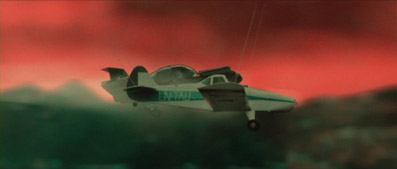
The Dolby 2.0 stereo is pretty good, but the Dolby 5.1 surround track is the one to go for – its dialogue may be locked to the front and centre, but the sound effects make splendid use of the full sound stage (the underwater sequences and assault on the came are an aural treat) and the music is more richer and full bodied than it's tinnier rendition on the stereo track.
Deleted Scenes (7:24)
Three deleted scenes entitled Treholt and the King, You Stay Here and A Peaceful Solution. All are of interest but add little to what we already know.
Bonus Scenes
This section is subdivided into six offbeat featurettes.
Action Figures (0:55)
What looks like a fake commercial for action figures based on the movie and visually downgraded to have the look of a second generation VHS recording.
Home Alone with Otto (1:30)
Stay Behind leader Otto Meyer exercises, shoots, and practices his martial arts to music.
Life on Grassy Island (4:13)
A structureless observational portrait of life on the idyllic island of the ninja base, constructed largely from clips from the film.
Oddities and Bloopers (5:15)
Just what it says, a varied collection of out-takes and odd moments caught on camera. This does show how the Grassy Island footage looked before the sepia overload, and just how many takes it took for leading man Ousdal to pull off the cigarette-in-the-mouth trick he does with such flair in the film.
Pyrotechnics (2:26)
A montage of effects explosions and fire effects used in the film, plus a couple of tests.
Wingsuits (4:43)
A bit of a jaw-dropper this, at least for this greenhorn, as the wing-suits used in the film – which I had assumed were faked through CG but are actually a popular variant of base jumping – are flown for real over sometimes precarious mountain terrain and photographed by a similarly kitted out cameraman. It's exhilarating footage that includes a parachute landing in which the camera operator gets stuck in a tree.
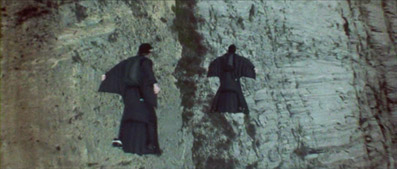
Featurettes
Another six featurettes, though these are more structured than the above and directly concerned with the making of the film and all are front labelled for authorised personnel only, which I presume means us.
Fight Choreography (8:27)
Stunt co-ordinator Kristoffer Jørgensen (who plays ninja Tromsø in the film) provides a brief look at the film's fight choreography, the bulk of which involves the rehearsal and shooting of scene in which the ninjas are played by athletic hip-hop artists.
Interview (13:35)
Silje Riise Næss interviews director Thomas Cappelen Malling, producer Eric Vogel and (eventually) leading man Mads Ousdal in front of a live audience at Parkteateret in Oslo on 7th April 2010. Malling is as amusingly deadpan as his film and sticks to the line that every word of it is true (he even claims that he was first attracted to the story by the idea of a master ninja being arrested at an airport by "a bunch of dumb cops") but gives a reasonably accurate history of ninja origins. Ousdal chips in about the director's working style and the silliness of working on the torpedo sub sequence.
Kielland (4:47)
Director Malling talks about the filming of the Kielland oil rig assault (one of a number of real-life disasters worked into the plot) and we get a behind-the-scenes peek at the filming of the live action and model work. In true low budget style, Malling openly reveals that his use of various visual styles – night vision, security cameras, etc. – was primarily to disguise where and when they were actually filming.
Music Studio (6:48)
Gaute Tønder talks about being elevated from bit part player to the film's composer and works with actor and musician Amund Maarud (who plays star pupil Bumblebee) to record his character's theme.
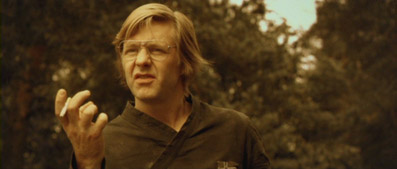
Skycar (2:02)
A blend of introduction, on-set footage, raw model work and film clips show how the Skycar escape sequence was shot.
Torpedo (3:58)
Similar to the above, but for the torpedo submarine sequence.
B-Roll (3:16)
A small, commentary-free collection of behind-the-scenes footage.
TV Spots (0:34)
Two brief Norwegian TV spots, both of them subtitled.
Music Video (4:06)
Extracts from the film cut to the main dance track theme. Nothing special.
Teasers (1:54)
Four intriguing teaser trailers, the last of which has Otto Meyer assuring us that none of us will see this film and ending his piece with "Greetings from Stay Behind. Fuck you, guys."
Trailer (1:46)
A pretty good sell that captures the flavour of the film.
Daft, uneven, and very much tied to Norwegian culture and history, Norwegian Ninja is still funny, inventive, and a good deal of fun. The transfer is probably as good as you're likely to get given the games played with the image in post-production, and the extra features, though a little uneven, are plentiful and add to the sense that the project was the the work of enthusiastic pranksters. For this and the film itself, eOne's disc comes cheerfully recommended.
|